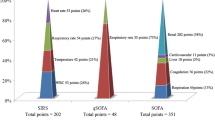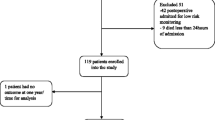Abstract
Objective
To determine whether severity and organ failure scores over the first 3 days in an ICU predict in-hospital mortality in onco-hematological malignancy patients.
Design and setting
Retrospective study in a 22-bed medical ICU.
Patients
92 consecutive patients with onco-hematological malignancies including 20 hematopoietic stem cell transplantation (HSCT) patients (11 with allogenic HSCT).
Measurements
Simplified Acute Physiology Score (SAPS) II, Organ Dysfunction and/or Infection (ODIN) score, Logistic Organ Dysfunction System (LODS), and Sequential Organ Failure Assessment (SOFA) score were recorded on admission. The change in each score (Δ score) during the first 3 days in the ICU was calculated as follows: severity or organ failure score on day 3 minus severity or organ failure score on day 1, divided by severity or organ failure score on day 1.
Results
In-hospital mortality was 58%. Using multivariate analysis in-hospital mortality was predicted by all scores on day 1 and all Δ scores. Areas under the receiver operating characteristics curves were similar for SAPS II (0.78), ODIN (0.78), LODS (0.83), and SOFA (0.78) scores at day 1. They were also similar for ΔSAPS II, ΔODIN, ΔLODS, and ΔSOFA. Similar results were observed when excluding patients with allogenic HSCT.
Conclusion
Severity and three organ failure scores on day 1 and Δ scores perform similarly in predicting in-hospital mortality in ICU onco-hematological malignancy patients but do not predict individual outcome. Decision to admit such patients to the ICU or to forgo life-sustaining therapies should not be based on these scores.

Similar content being viewed by others
References
Task Force of the American College of Critical Care Medicine, Society of Critical Care Medicine (1999) Guidelines for intensive care unit admission, discharge, and triage. Crit Care Med 26:633–638
Society of Critical Care Medicine Ethics Committee (1994) Consensus statement on the triage of critically ill patients. JAMA 271:1200–1203
Azoulay E, Pochard F, Chevret S, Vinsonneau C, Garrouste M, Cohen Y, Thuong M, Paugam C, Apperre C, De Cagny B, Brun F, Bornstain C, Parrot A, Thamion F, Lacherade JC, Bouffard Y, Le Gall JR, Herve C, Grassin M, Zittoun R, Schlemmer B, Dhainaut JF, Protocetic Group (2001) Compliance with triage to intensive care recommandations. Crit Care Med 29:2132–2136
Sprung CL, Geber D, Eidelman LA, Baras M, Pizov R, Nimrod A, Oppenheim A, Epstein L, Cotev S (1999) Evaluation of triage decisions for intensive care admission. Crit Care Med 27:1073–1079
Azoulay E, Recher C, Alberti C, Soufir L, Leleu G, Le Gall JR, Fermand JP, Schlemmer B (1999) Changing use of intensive care for hematological patients: the example of multiple myeloma. Intensive Care Med 25:1395–1401
Kress JP, Christenson J, Pohlman AS, Linkin DR, Hall JB (1999) Outcomes of critically ill cancer patients in a university hospital setting. Am J Respir Crit Care Med 160:1957–1961
Staudinger T, Stoiser B, Mullner M, Locker GJ, Laczika K, Knapp S, Burgmann H, Wilfing A, Kofler J, Thalhammer F, Frass M (2000) Outcome and prognostic factors in critically ill cancer patients admitted to the intensive care unit. Crit Care Med 28:1322–1328
Kroschinsky F, Weise M, Illmer T, Haenel M, Bornhaeuser M, Hoeffken G, Ehninger G, Schuler U (2002) Outcome and prognostic features of intensive care unit treatment in patients with haematological malignancies. Intensive Care Med 28:1294–1300
Price KJ, Thall PF, Kish SK, Shannon VR, Andersson BS (1998) Prognostic indicators for blood and marrow transplant patients admitted to an intensive care unit. Am J Respir Crit Care Med 158:876–884
Darmon M, Azoulay E, Alberti C, Fieux F, Moreau D, Le Gall JR, Schlemmer B (2002) Impact of neutropenia duration on short-term mortality in neutropenic critically ill cancer patients. Intensive Care Med 28:1775–1780
Khassawneh BY, White P Jr, Anaissie EJ, Barlogie B, Hiller FC (2002) Outcome from mechanical ventilation after autologous peripheral blood stem cell transplantation. Chest 121:185–188
Blot F, Guiguet M, Nitenberg G, Leclercq B, Gachot B, Escudier B (1997) Prognostic factors for neutropenic patients in an intensive care unit: respective roles of underlying malignancies and acute organ failures. Eur J Cancer 33:1031–1037
Massion PB, Dive AM, Doyen C, Bulpa P, Jamart J, Bosly A, Installe E (2002) Prognosis of hematologic malignancies does not predict intensive care unit mortality. Crit Care Med 30:2260–2270
Sculier JP, Paesmans M, Markiewicz E, Berghmans T (2000) Scoring systems in cancer patients admitted for an acute complication in a medical intensive care unit. Crit Care Med 28:2786–2792
Soares M, Fontes F, Dantas J, Gadelha D, Cariello P, Nardes F, Amorim C, Toscano L, Rocco JR (2004) Performance of six severity-of-illness scores in cancer patients requiring admission to the intensive care unit: a prospective observational study. Crit Care 8:R194–R203
Benoit DD, Vandewoude KH, Decruyenaere JM, Hoste EA, Colardyn FA (2003) Outcome and early prognostic indicators in patients with a hematologic malignancy admitted to the intensive care unit for a life-threatening complication. Crit Care Med 31:104–112
Timsit JF, Fosse JP, Troche G, De Lassence A, Alberti C, Garrouste-Orgeas M, Azoulay E, Chevret S, Moine P, Cohen Y (2001) Accuracy of a composite score using daily SAPS II and LOD scores for predicting hospital mortality in ICU patients hospitalized for more than 72 h. Intensive Care Med 27:1012–1021
Timsit JF, Fosse JP, Troche G, De Lassence A, Alberti C, Garrouste-Orgeas M, Bornstain C, Adrie C, Cheval C, Chevret S, for the OUTCOMEREA Study Group, France (2002) Calibration and discrimination by daily Logistic Organ Dysfunction scoring comparatively with daily Sequential Organ Failure Assessment scoring for predicting hospital mortality in critically ill patients. Crit Care Med 30:2003–2013
Schellongowski P, Benesch M, Lang T, Traunmuller F, Zauner C, Laczika K, Locker GJ, Frass M, Staudinger T (2004) Comparison of three severity scores for critically ill cancer patients. Intensive Care Med 30:430–436
Guiguet M, Blot F, Escudier B, Antoun S, Leclercq B, Nitenberg G (1998) Severity of 2illness scores for neutropenic cancer patients in an intensive care unit: which is the best predictor? Do multiple assessment times improve the predictive value? Crit Care Med 26:488–493
Larche J, Azoulay E, Fieux F, Mesnard L, Moreau D, Thiery G, Darmon M, Le Gall JR, Schlemmer B (2003) Improved survival of critically ill cancer patients with septic shock. Intensive Care Med 29:1688–1695
Rubenfeld GD, Crawford SW (1996) Withdrawing life support from mechanically ventilated recipients of bone marrow transplants: a case for evidence-based guidelines. Ann Intern Med 125:625–633
Fagon JY, Chastre J, Novara A, Medioni P, Gibert C (1993) Characterization of intensive care unit patients using a model based on the presence or absence of organ dysfunctions and/or infection: the ODIN model. Intensive Care Med 19:137–144
Le Gall JR, Klar J, Lemeshow S, Saulnier F, Alberti C, Artigas A, Teres D (1996) The Logistic Organ Dysfunction System. A new way to assess organ dysfunction in the intensive care unit. JAMA 276:802–810
Vincent JL, Moreno R, Takala J, Willatts S, De Mendonca A, Bruining H, Reinhart CK, Suter PM, Thijs LG (1996) The SOFA (Sepsis-related Organ Failure Assessment) score to describe organ dysfunction/failure: on behalf of the Working Group on Sepsis-Related Problems of the European Society of Intensive Care Medicine. Intensive Care Med 22:707–710
Le Gall JR, Lemeshow S, Saulnier F (1993) A new simplified acute physiologic score (SAPS II) based on a European/North American multicenter study. JAMA 270:2957–2964
Lemeshow S, Hosmer DW Jr (1982) A review of goodness-of-fit statistics for use in the development of logistic regression models. Am J Epidemiol 115:92–106
DeLong ER, DeLong DM, Clarke-Pearson DL (1988) Comparing the areas under two or more correlated receiver operating characteristics curves: a non parametric approach. Biometrics 44:837–845
Groeger JS, Lemeshow S, Price K, Nierman DM, White P Jr, Klar J, Granovsky S, Horak D, Kish SK (1998) Multicenter outcome study of cancer patients admitted to the intensive care unit: a probability of mortality model. J Clin Oncol 16:761–770
Berghmans T, Paesmans M, Sculier JP (2004) Is a specific oncological scoring system better at predicting the prognosis of cancer patients admitted for an acute medical complication in an intensive care unit than general gravity scores? Support Care Cancer 12:234–239
Knaus WA, Draper EA, Wagner DP, Zimmerman JE (1985) APACHE II: a severity of disease classification system. Crit Care Med 13:818–829
Acknowledgements
We thank Jean-Louis Teboul for his fruitful comments for reviewing the manuscript and Mary Kenny for her valuable advice for editing the manuscript. Part of this study was presented in abstract form at the American Thoracic Society International Conference at San Diego in May 2005 (American Journal of Respiratory and Critical Care Medicine, vol. 2, A430).
Author information
Authors and Affiliations
Corresponding author
Electronic supplementary material
Rights and permissions
About this article
Cite this article
Lamia, B., Hellot, MF., Girault, C. et al. Changes in severity and organ failure scores as prognostic factors in onco-hematological malignancy patients admitted to the ICU. Intensive Care Med 32, 1560–1568 (2006). https://doi.org/10.1007/s00134-006-0286-3
Received:
Accepted:
Published:
Issue Date:
DOI: https://doi.org/10.1007/s00134-006-0286-3




